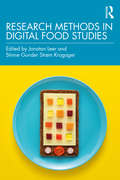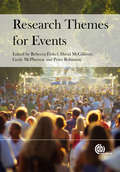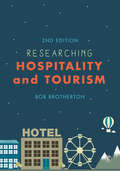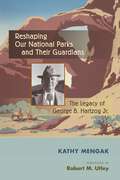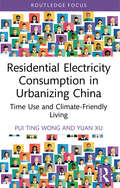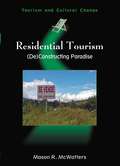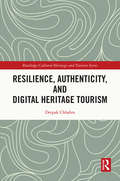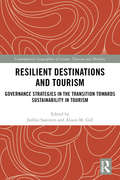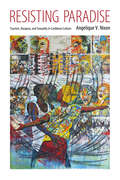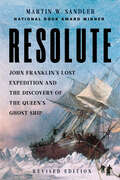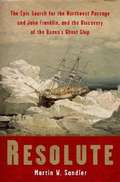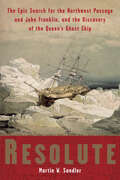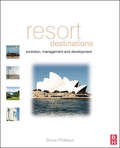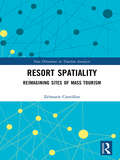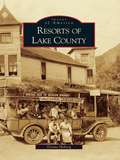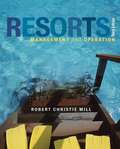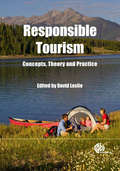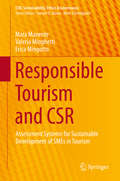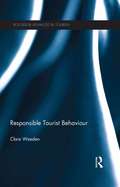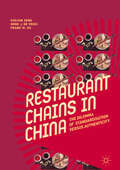- Table View
- List View
Research Methods in Digital Food Studies
by Jonatan Leer Stinne Gunder Strøm KrogagerThis book offers the first methodological synthesis of digital food studies. It brings together contributions from leading scholars in food and media studies and explores research methods from textual analysis to digital ethnography and action research. In recent times, digital media has transformed our relationship with food which has become one of the central topics in digital and social media. This spatiotemporal shift in food cultures has led us to reimagine how we engage in different practices related to food as consumers. The book examines the opportunities and challenges that the new digital era of food studies presents and what methodologies are employed to study the changed dynamics in this field. These methodologies provide insights into how restaurant reviews, celebrity webpages, the blogosphere and YouTube are explored, as well as how to analyse digital archives, digital soundscapes and digital food activism and a series of approaches to digital ethnography in food studies. The book presents straightforward ideas and suggestions for how to get started on one’s own research in the field through well-structured chapters that include several pedagogical features. Written in an accessible style, the book will serve as a vital point of reference for both experienced researchers and beginners in the digital food studies field, health studies, leisure studies, anthropology, sociology, food sciences, and media and communication studies.
Research Methods in Tourism, Hospitality and Events Management
by Professor Paul Brunt Dr Susan Horner Dr Natalie SemleyIn Research Methods in Tourism, Hospitality and Events Management, the authors use a step-by-step approach to guide students through the whole research process, from initial ideas, through to writing up and presenting the findings. Coverage of the Internet and the digital environment as a space to carry out research has been included, and the use of technology in analysis such as SPSS, NVivo and Qualtrics is covered alongside the more traditional ‘by-hand’ methods. Hints, tips, exercises as well as end-of-chapter case studies demonstrate real challenges and practical examples from a variety of settings to help students understand how to manage and present their own research. The book is complemented by examples of tourism destinations from Spain, Switzerland, Italy and India, and a selection of PowerPoint slides for lecturers. Suitable for undergraduate and foundation degree students undertaking a research project in Tourism, Hospitality or Events Management.
Research Methods in Tourism, Hospitality and Events Management
by Susan Horner Paul Brunt Natalie SemleyIn Research Methods in Tourism, Hospitality and Events Management, the authors use a step-by-step approach to guide students through the whole research process, from initial ideas, through to writing up and presenting the findings. Coverage of the Internet and the digital environment as a space to carry out research has been included, and the use of technology in analysis such as SPSS, NVivo and Qualtrics is covered alongside the more traditional ‘by-hand’ methods. Hints, tips, exercises as well as end-of-chapter case studies demonstrate real challenges and practical examples from a variety of settings to help students understand how to manage and present their own research. The book is complemented by examples of tourism destinations from Spain, Switzerland, Italy and India, and a selection of PowerPoint slides for lecturers. Suitable for undergraduate and foundation degree students undertaking a research project in Tourism, Hospitality or Events Management.
Research Themes for Events
by Peter Robinson Joe Goldblatt Alan Clarke Larry Dwyer Gordon Waitt Kevin Markwell Gayle Mcpherson Laura Misener Debra Wale Matthew Frew Anna Borley Gemma Gelder Allan Jepson Jennifer Jones Rebecca Finkel David Mcgillivray John Nauright Gordon Hunt Andrea Giampiccoli Seungwon Lee Leo Jago Clare Mackay Malcolm Foley*The first book to cover events management from a research angle *Includes a number of case studies to provide a well-rounded approach to the subject *Addresses key concepts, theories and discussions around subjects such as consumer behaviour, authenticity and new technology
Research Themes for Events
by Joe Goldblatt Alan Clarke Larry Dwyer Gordon Waitt Kevin Markwell Laura Misener Debra Wale Matthew Frew Anna Borley Gemma Gelder Allan Jepson Jennifer Jones John Nauright Gordon Hunt Andrea Giampiccoli Seungwon Lee Leo Jago Clare Mackay Malcolm Foley*The first book to cover events management from a research angle *Includes a number of case studies to provide a well-rounded approach to the subject *Addresses key concepts, theories and discussions around subjects such as consumer behaviour, authenticity and new technology
Researching Hospitality and Tourism
by Bob Brotherton"Takes readers systematically through the entire research process from the formulation of the aim to the presentation of the dissertation... a key subject-specific resource in our fields." - Dr Peter Lugosi, Oxford Brookes University "Currently the leading book of its kind... students and other novice researchers will find it accessible and user-friendly. Highly recommended." - Professor Roy C. Wood, University of Macau Bob Brotherton offers an uncluttered guide to the key concepts and essential research techniques in hospitality and tourism. By providing an authoritative introduction, students are taken through the issues and decisions that need to be considered to conceive, plan, conduct and write up a research project. With updates to every chapter and an array of practical examples, this new edition takes students step-by-step through each decision and action stage of the research process, from identifying a topic and formulating the research question to carrying out research and analysing findings. A companion website will provide a host of student resources including links to video and web resources, suggested further reading, free to download journal articles, and test questions for each chapter.
Researching Hospitality and Tourism
by Bob Brotherton"Takes readers systematically through the entire research process from the formulation of the aim to the presentation of the dissertation... a key subject-specific resource in our fields." - Dr Peter Lugosi, Oxford Brookes University "Currently the leading book of its kind... students and other novice researchers will find it accessible and user-friendly. Highly recommended." - Professor Roy C. Wood, University of Macau Bob Brotherton offers an uncluttered guide to the key concepts and essential research techniques in hospitality and tourism. By providing an authoritative introduction, students are taken through the issues and decisions that need to be considered to conceive, plan, conduct and write up a research project. With updates to every chapter and an array of practical examples, this new edition takes students step-by-step through each decision and action stage of the research process, from identifying a topic and formulating the research question to carrying out research and analysing findings. A companion website will provide a host of student resources including links to video and web resources, suggested further reading, free to download journal articles, and test questions for each chapter.
Reshaping Our National Parks and Their Guardians: The Legacy of George B. Hartzog Jr.
by Kathy MengakThis biography of the seventh director of the National Park Service brings to life one of the most colorful, powerful, and politically astute people to hold this position. George B. Hartzog Jr. served during an exciting and volatile era in American history. Appointed in 1964 by Secretary of the Interior Stewart Udall, he benefited from a rare combination of circumstances that favored his vision, which was congenial with both President Lyndon Johnson&’s &“Great Society&” and Udall&’s robust environmentalism.Hartzog led the largest expansion of the National Park System in history and developed social programs that gave the Service new complexion. During his nine-year tenure, the system grew by seventy-two units totaling 2.7 million acres including not just national parks, but historical and archaeological monuments and sites, recreation areas, seashores, riverways, memorials, and cultural units celebrating minority experiences in America. In addition, Hartzog sought to make national parks relevant and responsive to the nation&’s changing needs.
Residential Electricity Consumption in Urbanizing China: Time Use and Climate-Friendly Living (Routledge Focus on Energy Studies)
by Yuan Xu Pui Ting WongThis book forges a link between residential CO2 emissions and time use, focussing on China as a key case study. To provide a better understanding of the energy implications of the lifestyle differences between urban and rural China, Pui Ting Wong and Yuan Xu utilise time-use methodology as an alternative way to explore the links between individual lifestyle and residential electricity consumption. They begin by examining how Chinese citizens divide their time between daily activities, highlighting patterns around indicators including age, gender, education, and economic status. They go on to quantify CO2 intensities of these time-use activities. Through this linkage, this book presents an alternative strategy for climate-friendly living, highlighting the ways in which urban planning can be deployed to help individuals adapt their time-use patterns for CO2 mitigation. Providing a novel contribution to the growing literature on residential electricity consumption, Residential Electricity Consumption in Urbanizing China will be of great interest to scholars of climate policy, energy studies, time use, and urban planning.
Residential Tourism
by Mason R. McwattersResidential Tourism: (De)Constructing Paradise offers the first in-depth, critical exploration of the foreign retirement/expatriate communities proliferating in both size and number throughout Latin America. Amidst the widespread development and promotion of international destinations of residential "paradise" intended for retirement, leisure, and experiences of exotica, this book draws on a diversity of perspectives in order to analyze the social and spatial impacts that dynamic phenomenon has on the people and places it directly affects at the local level. Utilizing the community of Boquete, Panama as a case study, this book examines how two diverse residential groups - the native community who have lived in the area for generations and the foreign residential tourists who have just recently relocated abroad - coexist in a shared place of home, define their experiences of place and community, and confront the mass development of residential tourism in Boquete.
Resilience, Authenticity and Digital Heritage Tourism (Routledge Cultural Heritage and Tourism Series)
by Deepak ChhabraThis book examines the authentication of authenticity in heritage tourism by using a resilient smart systems approach. It discusses the emerging trends in cultural tourism and outlines, in a detailed manner, their significance in negotiating authenticity in tourism experience. Authentication of authenticity is an evolving, less-researched field of inquiry in heritage tourism. This book advances research on this subject by exploring different authentication processes and scrutinizes their resilience in building transformative heritage tourism pathways. It offers a kaleidoscopic view of the manner authenticity has evolved over the last several decades by observing a broad spectrum of cultural expressions. The evolution and meaningfulness of negotiated authenticity is identified and discussed in the context of pre-, intra- and post-pandemic times. This book focuses on the moral and existentialist trajectories or authenticity and the notion of self-authentication. It proposes a smart resilient authentication model to delicately negotiate the objective and self-dimensions of authenticity in transformative times. Furthermore, by sharing examples of best practices, it offers unique insights on how authenticity is authenticated and mediated via digital platforms and artificial intelligence. This book offers novel perspectives on negotiated authenticity and its authentication in heritage tourism and will appeal to both practitioners and students/scholars in Heritage studies; Design and Innovation; Tourism Studies; Geography and Planning across North America, Europe, and East-Asian countries.
Resilient Destinations and Tourism: Governance Strategies in the Transition towards Sustainability in Tourism (Contemporary Geographies of Leisure, Tourism and Mobility)
by Jarkko Saarinen Alison M. GillSustainability is one of the most important issues currently facing the tourism sector. Recently, the role of resilience thinking has been highlighted in sustainable development discussions as an alternative perspective. This book approaches these concepts as interwoven processes and looks at change through a socioecological lens. Instead of seeing resilience and sustainability as alternative approaches, Resilient Destinations and Tourism argues that resilience should be understood as a fundamental part of sustainable tourism thinking for destination systems, and calls for better governance in implementation and management. Improving governance is the key issue in sustainable tourism development. The chapters in this edited collection focus on resilient destinations from a governance perspective, in which tourism resilience is contextualized as an integral part of pathway creation in the process of moving towards sustainable tourism. The contributions to the book represent a range of theoretical and empirical approaches with a wide international scope. Resilient Destinations and Tourism calls for rethinking the meaning of sustainable development in tourism and looks at how sustainability and resilience could be integrated. This book will appeal to a wide range of research disciplines and students whose modules focus on the relationship between tourism and sustainability planning, governance, the environment, and hazards and disasters.
Resisting Paradise: Tourism, Diaspora, and Sexuality in Caribbean Culture (Caribbean Studies Series)
by Angelique V. NixonWinner of the Caribbean Studies Association's 2016 Barbara T. Christian Award for Best Book in the Humanities Tourists flock to the Caribbean for its beaches and spread more than just blankets and dollars. Indeed, tourism has overly affected the culture there. Resisting Paradise explores the import of both tourism and diaspora in shaping Caribbean identity. It examines Caribbean writers and others who confront the region's overdependence on the tourist industry and the many ways that tourism continues the legacy of colonialism. Angelique V. Nixon interrogates the relationship between culture and sex within the production of “paradise” and investigates the ways in which Caribbean writers, artists, and activists respond to and powerfully resist this production. Forms of resistance include critiquing exploitation, challenging dominant historical narratives, exposing tourism's influence on cultural and sexual identity in the Caribbean and its diaspora, and offering alternative models of tourism and travel. Resisting Paradise places emphasis on the Caribbean people and its diasporic subjects as travelers and as cultural workers contributing to alternate and defiant understandings of tourism in the region. Through a unique multidisciplinary approach to comparative literary analysis, interviews, and participant observation, Nixon analyzes the ways Caribbean cultural producers are taking control of representation. While focused mainly on the Anglophone Caribbean, the study covers a range of territories including Antigua, the Bahamas, Grenada, Haiti, Jamaica, as well as Trinidad and Tobago, to deliver a potent critique.
Resolute: John Franklin's Lost Expedition and the Discovery of the Queen's Ghost Ship
by Martin W. SandlerFew know that the president&’s desk in the Oval Office plays a part in one of the world&’s most extraordinary sagas; in Resolute, noted historian Martin Sandler brings the story to light. After Sir John Franklin and his ships disappeared in the Arctic while seeking the Northwest Passage, 39 rescue missions were launched, including one by the Resolute, the Royal Navy&’s finest vessel. In 1854, it became locked in the ice and was abandoned. A year later, a Connecticut whaling ship discovered it drifting 1,200 miles away, a 600-ton ghost ship. The whalers boarded the Resolute and steered it through a ferocious hurricane back to Connecticut. The US government re-outfitted the ship and returned it to Queen Victoria, who, in 1879, had its best timbers made into a desk for President Rutherford B. Hayes—a desk still in use today. Rare photographs, paintings, engravings, and maps illustrate the book throughout. This edition is updated with a new chapter on the discovery of Franklin&’s ships, the HMS Erebus and the HMS Terror, in 2014 and 2016 in the Canadian Arctic Archipelago. This legendary maritime epic is perfect for fans of David Grann&’s The Wager and Hampton Sides&’s The Wide Wide Sea.
Resolute: The Epic Search for the Northwest Passage and John Franklin, and the Discovery of the Queen's Ghost Ship
by Martin W. SandlerThis amazing high-seas adventure encompasses the search for the Northwest Passage in the early 1800s; a renowned explorer and his crew of 128 men who vanish during an 1845 expedition; 39 incredible, heroic attempted rescue missions; a ghost ship that drifts for more than 1,200 miles; a queen's gratitude.
Resolute: The Epic Search for the Northwest Passage and John Franklin, and the Discovery of the Queen's Ghost Ship
by Martin W. SandlerThe National Book Award–winning author “pulls off a significant historic and literary achievement . . . by melding the stories of two historic searches” (The Associated Press).Acclaimed historian Martin Sandler—a two-time Pulitzer Prize nominee, winner of seven Emmy® Awards, and author of more than fifty books—finally brings to light an amazing high-seas adventure. Fascinating rare photographs, paintings, engravings, and maps illustrate the book throughout.It all began when, in one of the biggest news stories of the 19th century, Sir John Franklin and his ships the Erebus and the Terror disappeared while attempting to locate the fabled Northwest Passage. At the request of Franklin’s wife, Lady Jane, the first mission set out from England in hopes of finding him; many others followed in its wake, none successful.Among these was the Resolute, the finest vessel in Queen Victoria’s Navy. But in 1854 it became locked in Arctic ice and was abandoned by its captain. A year later, a Connecticut whaler discovered it 1,200 miles away—drifting and deserted, a 600-ton ghost ship. He and his small crew boarded the Resolute, and steered it through a ferocious hurricane back to New London, Connecticut. The United States government then reoutfitted the ship and returned it to the thankful Queen. In 1879, when the Resolute was finally retired, she had the best timbers made into a desk for then-President Rutherford B. Hayes. It is still used by U.S. presidents today . . . one of the most celebrated pieces of furniture in the White House.“[A] gripping historical adventure.” —Publishers Weekly
Resort Destinations
by Bruce PrideauxDestination management and resort development and planning are strong core areas in the final year of most undergraduate degrees and a popular area of study at postgraduate level. Using original case studies based on his own research, Resort Destinations uses examples from Australia's Gold Coast, Britain's Brighton, USA's Las Vegas, as well as Hong Kong, New Zealand and the Caribbean.
Resort Spatiality: Reimagining Sites of Mass Tourism (New Directions in Tourism Analysis)
by Zelmarie CantillonThis book theorises resorts as distinct kinds of urban milieux, capturing the complexity of destinations famous for ‘sun, sand and sex’ mass tourism. Drawing on qualitative field research (participant observation, interviews and photography), the book discusses examples from six international resort destinations spread across four continents: the Gold Coast, Australia; Phuket and Koh Phangan, Thailand; Cancún, Mexico; Miami, USA; and Ibiza, Spain. The book reviews the material and symbolic production of lived spaces in these resorts, considering the mutually constitutive, mutually transformative relations between their spatial formations, built environments, popular imaginaries, representations, narratives of identity, rhythms, and the experiences and practices of both tourists and locals. In doing so, it argues for more nuanced ways of conceptualising tourism, globalisation and spatiality, reimagining how these phenomena unfold in lived spaces. Taking a cultural studies approach to urban analysis, the book demonstrates the value in embracing complexity, fluidity, partiality and uncertainty. It will be of interest to students and researchers of tourism, geography, cultural studies, development studies, anthropology and sociology.
Resorts and Ports
by Peter Borsay John K. WaltonHistories of seaports and coastal resorts have usually been kept in separate compartments. This book brings them together and looks at how resort development affected historic ports during the rise and development of the seaside holiday in Europe from the 18th century to the 20th, and what the attributes of ports (fishing, harbour crafts, the whiff of the exotic, fishermen's homes and families) contributed to the attractions of resorts. Case-studies drawn from across Europe, from Wales and the Netherlands to Norway, Latvia and Spain, bring original perspectives to bear on these histories and relationships, and consider their influence on seaside heritage and regeneration at a time when coastal settlements are increasingly using their past to secure their future. The book will interest academics in tourism studies, history, geography and cultural studies, as well as provide essential information and analysis for policy-makers in coastal regeneration.
Resorts of Lake County
by Donna HobergBeginning in the 1860s, the first vestiges of the resorts of Lake County appeared around the sparkling pools of the region's many hot springs and upon the shores of Clear Lake. Lured by the supposed medicinal qualities of the water, people flocked to rustic campgrounds and cabins to "take the cure" for their ailments, drink, and bathe, staying for long periods each summer. Within a few years, ambitiousentrepreneurs bottled the springs' mineral waters and built more luxurious accommodations and amenities. Although the claims of curative waters lost sway over time, resorts equipped with extensiverecreational facilities, dance floors, live music, bountiful food, hunting, fishing, and children's entertainment continued to draw visitors in droves. Families filled the resorts in summers, and by the 1940s, large group and society meetings as well as conventions began to utilize the resorts on spring and fall weekends. Though few original resorts remain, today, in 2007, the region's business directory lists 51 Lake County resorts.
Resorts: Management and Operation (Third Edition)
by Robert Christie MillThe 3rd Edition of Resorts: Management and Operation is a summary of almost 30 years of thought, analysis, and research into the field of resort management written from a business viewpoint yet takes into account the unique structure of resorts. The text is divided into three sections. Each section has a philosophical basis for the inclusion of the subsequent principles and practices. The first section covers major types of resorts: those that are mountain-based, beach-based and golf/tennis based. Two chapters are devoted to each of the various resort types. The first chapters of each resort type focuses on development issues with the impact on operations noted throughout. The second chapter in each resort type deals with guest profiles and management issues. The second section highlights what makes managing a resort different from managing a 'regular' hotel. The final section features a newly expanded chapter on spas, pools, and indoor water parks along with individual chapters on specialty resorts, cruise ships and casinos, reflecting the importance of these types of properties.
Responsible Tourism
by David Leslie Ralf C Buckley Professor Richard W Butler Dallen J Timothy Anita PleumaromTourism is one of the world's biggest industries. Responsible tourism is concerned with the effects of tourism on people, ecology, and communities, and seeks to ameliorate these impacts by providing tourism which benefits host communities, improves working conditions, involves the local community, promotes cultural heritage, and benefits the environment. This book discusses responsible tourism as a whole, including the politics, policy and planning behind it, and major sub-topics such as poverty reduction, the environment, transport, governance, wildlife tours and heritage.
Responsible Tourism and CSR
by Mara Manente Valeria Minghetti Erica MingottoWhat are Responsible Tourism and Corporate Social Responsibility? What is the industry's awareness regarding these concepts? What are the systems and tools currently available on the market that tourism SMEs can use to assess their engagement and the sustainability of their business? This book is aimed at replying to these questions and offering an innovative contribution to the current debate in the field. After having defined Responsible Tourism and CSR and the environment in which these methodologies develop, the authors present and compare the main European assessment and certification systems, describe their characteristics and functionalities and discuss the relevant issues concerning their application. Through the AHP model and the selection of a number of relevant case histories, the suitability and efficacy of these systems in monitoring the level of responsibility of tourism SMEs are analyzed and debated. The results obtained contribute to enhance the recognition and diffusion of CSR principles in tourism and to support tourism businesses in choosing the assessment tool that best fits with their characteristics and the nature of their activity. The study also enables students and researchers to build or enhance their knowledge about the main reporting initiatives available in Europe and to assess the potential of the mathematical model applied for this kind of study.
Responsible Tourist Behaviour (Advances in Tourism)
by Clare WeedenWhat is important to ethical consumers when thinking about going on holiday and how do they incorporate their lifestyle choices into these holidays? What values inform their lifestyles and how do they satisfy these values on holiday? Do ethical consumers automatically become ethical tourists or is the situation a little more complex than this? In an attempt to answer these questions, this book explores: The ethical dilemmas associated with tourism The concerns and motivations of ethical consumers on holiday The role and importance of values in holiday decision-making This book offers a highly original contribution to the debate surrounding the demand for ethical and responsible holidays. It explores the consumption concerns of ethical consumers and their motivational values, and offers a detailed examination of how they manage these values on holiday. This book offers a new and challenging perspective to the study of responsible tourism by providing a unique empirical insight into how responsible tourists incorporate their norms and values into their holiday decisions. The text will be of interest to undergraduates, postgraduates and tutors on courses that have tourism and the tourist at their centre, and to academics in other disciplines such as marketing and consumer behaviour. It will also be highly relevant to the global tourism industry.
Restaurant Chains in China: The Dilemma Of Standardization Versus Authenticity
by Frank M. Go Guojun Zeng Henk J. de VriesThis book explores the paradox of the hospitality industry: customers demand not only personal and innovative tourism products and services, but also cost-effective ones. Enterprises have the option to meet the former demand by offering authentic products and services while the latter could be achieved through standardization. Although it seems ideal to combine both concepts, they seemingly contradict each other leading to suppliers facing an authenticity-standardization paradox. The authors identify, analyze, and provide solutions for this authenticity-standardization paradox based on a series of case studies of restaurants in China. This book will be of interest to scholars, business owners, and consultants.
